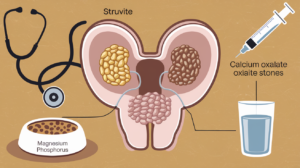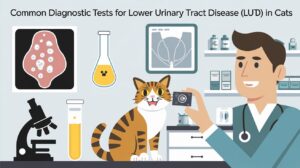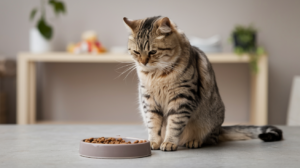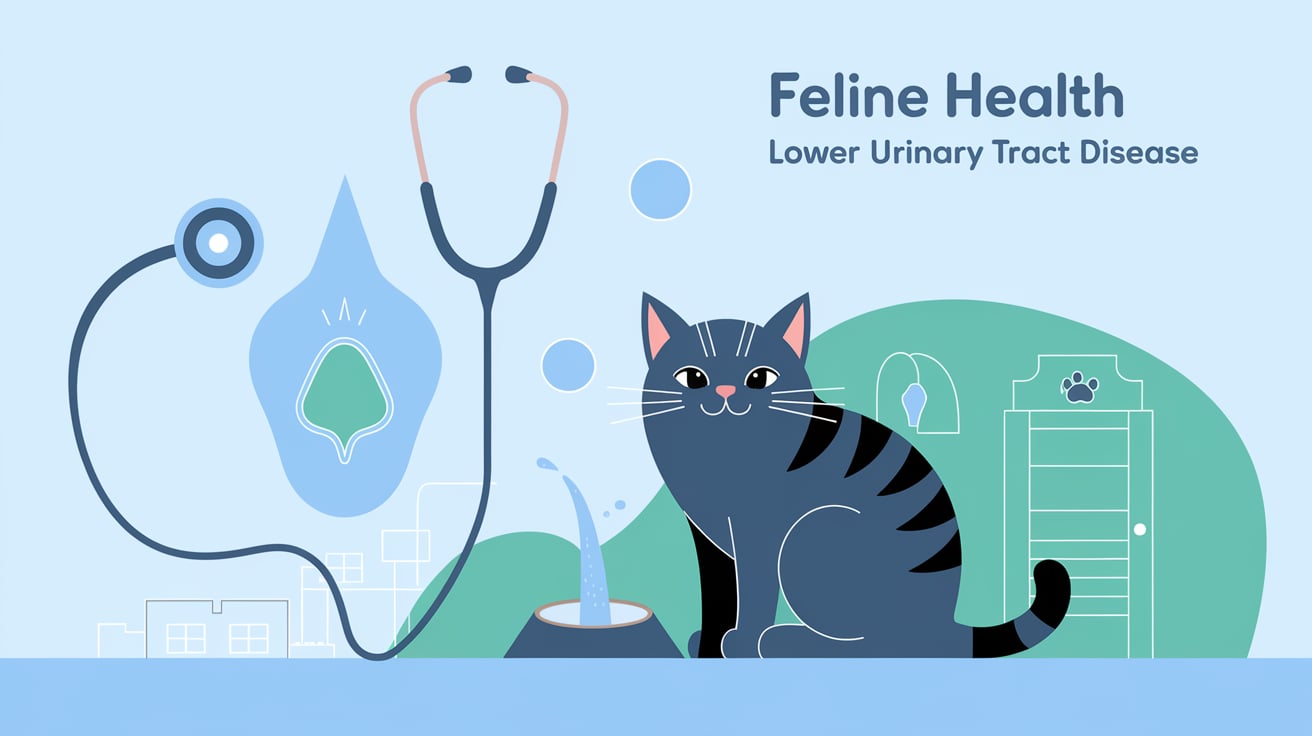Introduction
Lower urinary tract disease in cats is a common and often serious condition that affects the bladder and urethra, leading to a variety of symptoms. It is abbreviated as (LUTD) . This disease can manifest in multiple forms, including urinary tract infections, bladder stones, and inflammation. Cats with LUTD may experience discomfort while urinating, frequent attempts to urinate with little success, or even blood in their urine. Understanding LUTD is crucial for cat owners, as it can significantly impact their pet’s quality of life and may lead to more severe health issues if left untreated.
Recognizing and treating LUTD promptly is essential. Early intervention can alleviate pain and prevent complications such as urinary blockages, which can be life-threatening, especially in male cats. Cat owners should be vigilant about any changes in their pet’s urination habits or behavior, as these can be key indicators of underlying health issues. The earlier LUTD is diagnosed and managed, the better the outcomes for affected cats.
The purpose of this article is to provide cat owners with comprehensive information about lower urinary tract disease. We will discuss its causes, symptoms, diagnosis, and treatment options, equipping readers with the knowledge needed to recognize potential issues in their feline companions and seek appropriate veterinary care. By fostering awareness and understanding of LUTD, we can help ensure a healthier, happier life for our cats.
Understanding Lower Urinary Tract Disease
Lower urinary tract disease (LUTD) refers to a range of conditions affecting the bladder and urethra in cats. This term encompasses various issues, including urinary tract infections, bladder stones, and inflammation. Although LUTD can affect cats of any age, middle-aged and older cats are the most likely to experience it. The underlying causes of LUTD can vary, from dietary factors and stress to anatomical abnormalities. Understanding these factors is vital for pet owners to help manage and prevent this distressing condition in their feline companions.
Recognizing the common symptoms and signs of LUTD is crucial for early diagnosis and treatment. One of the most noticeable signs is frequent urination, where a cat may attempt to urinate more often than usual, often producing little to no urine. This can indicate a blockage or irritation in the urinary tract. Another significant symptom is straining to urinate. A cat may adopt a hunched posture, meow in discomfort, or spend an excessive amount of time in the litter box, trying to relieve itself.
Additional symptoms include blood in the urine, which may appear as a pink or red discoloration, and licking of the genital area, which indicates irritation or discomfort. Signs of discomfort may also manifest as restlessness, excessive grooming, or changes in behavior, such as hiding or vocalizing more than usual. Understanding these symptoms can help cat owners seek veterinary assistance promptly, ensuring their pets receive the necessary care for LUTD.
Causes of Lower Urinary Tract Disease
Urinary Tract Infections (UTIs)
Urinary tract infections (UTIs) occur when bacteria invade the urinary system, leading to inflammation and discomfort. Frequent urination, struggling to urinate, and blood in the urine are common signs of UTIs in cats. Affected cats may also show signs of discomfort, such as vocalizing during urination or spending an excessive amount of time in the litter box. Recognizing these symptoms is crucial for prompt treatment to prevent complications.
Several risk factors contribute to the development of UTIs in cats. These include age, sex, and underlying health conditions. Female cats are more prone to UTIs due to their shorter urethra, which makes it easier for bacteria to enter the urinary tract. Additionally, cats with weakened immune systems, diabetes, or other chronic conditions are at a higher risk for developing urinary infections. Maintaining good hygiene and regular veterinary check-ups can help reduce the risk of UTIs in feline companions.
Uroliths (Urinary Stones)
Uroliths, commonly known as urinary stones, are mineralized deposits that can form in the bladder or urethra, causing obstruction and discomfort. Struvite stones and calcium oxalate stones are the two most prevalent kinds of urinary stones in cats. While calcium oxalate stones usually appear in acidic urine and are not typically connected with infections, struvite stones frequently form in alkaline urine and are linked to UTIs.

Several factors contribute to stone formation in cats, including diet, genetics, and urinary pH. A diet high in certain minerals, such as magnesium and phosphorus, can increase the likelihood of struvite stone formation, while low water intake can lead to concentrated urine, promoting both types of stones. Regular veterinary visits and dietary adjustments can help prevent the formation of urinary stones in susceptible cats.
Feline Idiopathic Cystitis (FIC)
The complicated illness known as feline idiopathic cystitis (FIC) is characterized by bladder inflammation for which there is no known etiology. The exact triggers for FIC remain unclear, but stress and changes in the cat’s environment are believed to play a significant role. Symptoms of FIC include frequent urination, straining, and blood in the urine, similar to those seen in UTIs and uroliths.
Potential triggers for FIC can include changes in routine, introduction of new pets, or environmental stressors such as loud noises. Understanding these factors can help cat owners manage their pets’ environments to reduce the risk of FIC flare-ups. Providing a calm, enriched environment and ensuring access to clean water and appropriate litter boxes are essential steps in promoting urinary health.
Anatomical Issues
Anatomical issues can also contribute to LUTD in cats. Congenital abnormalities, such as urethral strictures or bladder malformations, can predispose a cat to urinary problems. These conditions may affect the normal flow of urine, leading to an increased risk of infections and stone formation.
If a cat is suspected to have anatomical issues, a thorough veterinary examination is necessary. Diagnostic imaging, such as X-rays or ultrasounds, can help identify these abnormalities and guide treatment decisions to ensure the cat’s urinary tract functions properly.
Stress and Environmental Factors
Stress and environmental factors have a significant impact on a cat’s urinary health. Cats are sensitive creatures, and changes in their environment, such as moving to a new home, adding new pets, or changes in their owner’s routine, can lead to increased anxiety. This stress can contribute to urinary issues, particularly FIC, and can exacerbate existing conditions.
Creating a stable, enriched environment is crucial for maintaining a cat’s emotional well-being. Providing safe spaces, engaging in play, and ensuring a consistent routine can help reduce stress levels. Additionally, considering feline-friendly practices, such as providing multiple litter boxes and vertical spaces for climbing, can contribute to a happier, healthier feline companion.
Diagnosis of Lower Urinary Tract Disease
Diagnosing lower urinary tract disease in cats requires a thorough veterinary consultation, as various conditions can present with similar symptoms. Seeking professional help is crucial because a timely and accurate diagnosis can prevent complications and ensure appropriate treatment. Veterinarians are trained to assess the cat’s history, clinical signs, and overall health, which is essential in determining the underlying cause of LUTD.
Once the veterinary consultation is complete, several diagnostic tests may be recommended. A urinalysis is often the first step, as it provides valuable information about the cat’s urinary health. This test examines the physical, chemical, and microscopic properties of the urine, helping to identify infections, crystals, or blood in the urine. A urinalysis is an essential tool in diagnosing conditions like urinary tract infections or the presence of uroliths.

In addition to urinalysis, imaging techniques such as X-rays and ultrasounds play a vital role in diagnosing LUTD. X-rays can reveal the presence of urinary stones or abnormalities in the urinary tract, while ultrasound provides detailed images of the bladder and surrounding structures, helping to identify conditions such as tumors or cysts. There may be situations where a cystoscopy is necessary. This procedure involves inserting a small camera into the bladder through the urethra, allowing direct visualization of the urinary tract and enabling biopsies to be taken if necessary.
Differential diagnoses are crucial in the diagnostic process, as many conditions can mimic LUTD symptoms. For example, conditions such as diabetes mellitus or hyperthyroidism may present with increased urination, while stress-related conditions like FIC can show similar signs. By systematically ruling out other potential causes through a combination of history, physical examination, and diagnostic tests, veterinarians can accurately diagnose LUTD and tailor a treatment plan specific to the cat’s needs.
Treatment Options for Lower Urinary Tract Disease
Medications
The treatment of lower urinary tract disease (LUTD) often begins with medications tailored to address the specific underlying condition. For urinary tract infections (UTIs), antibiotics are commonly prescribed to eliminate the bacteria causing the infection. It’s essential to complete the full course of antibiotics to ensure the infection is fully resolved and to prevent antibiotic resistance. In cases where cats experience pain or inflammation, pain relief and anti-inflammatory drugs may be administered to enhance comfort during recovery.
For conditions like feline idiopathic cystitis (FIC), specific medications can help manage symptoms. These may include anti-anxiety medications to reduce stress or supplements that promote bladder health. It’s vital for pet owners to work closely with their veterinarians to determine the best medication regimen based on their cat’s individual needs and health status.
Dietary Management
Diet plays a significant role in managing LUTD and maintaining urinary health in cats. Prescription diets specifically formulated for urinary health can help dissolve certain types of stones, such as struvite stones, and prevent their recurrence. These diets are designed to maintain optimal urine pH levels and reduce the concentration of minerals that contribute to stone formation.

Additionally, ensuring proper hydration is crucial for preventing LUTD. Cats are often not great drinkers, which can lead to concentrated urine and increase the risk of urinary issues. Encouraging hydration can be achieved by providing fresh water at all times, incorporating wet food into their diet, or using water fountains that attract cats to drink more. Keeping a well-hydrated cat can significantly contribute to overall urinary health.
Surgical Interventions
In some cases, surgical intervention may be necessary, particularly if there is a urinary obstruction caused by stones or other structural issues. Urinary obstructions can be life-threatening and require immediate attention. Surgery may involve the removal of stones, opening up the urethra, or correcting congenital abnormalities that impede urine flow. After surgery, close monitoring and follow-up care are essential to ensure the cat’s recovery and prevent future complications.
Behavioral and Environmental Modifications
Addressing behavioral and environmental factors is equally important in managing LUTD. Stress reduction techniques can significantly impact a cat’s urinary health, especially for those suffering from conditions like FIC. Creating a calm and stable environment can help alleviate stressors. Techniques such as providing hiding spots, interactive playtime, and maintaining a consistent routine can make a positive difference.
Encouraging regular urination is another key aspect of management. Providing multiple litter boxes in quiet, accessible locations encourages cats to use them frequently. Maintaining clean litter boxes and using different types of litter can help cater to individual preferences, making the process more appealing. By addressing both medical and environmental factors, pet owners can help their cats achieve better urinary health and overall well-being.
Prevention of Lower Urinary Tract Disease
Preventing lower urinary tract disease in cats is essential for maintaining their overall health and well-being. A proactive approach can significantly reduce the risk of developing urinary issues and enhance the quality of life for feline companions.
Importance of Regular Veterinary Check-Ups
One of the most effective ways to prevent LUTD is through regular veterinary check-ups. Routine examinations allow veterinarians to monitor the cat’s health, identify potential issues early, and provide necessary vaccinations. During these visits, veterinarians can conduct urinalysis and blood tests to assess the cat’s urinary health, ensuring any underlying problems are addressed promptly. Early detection of health concerns can lead to more effective treatment and prevention strategies.
Dietary Recommendations
Dietary management plays a critical role in preventing LUTD. Feeding a high-quality, balanced diet tailored to a cat’s specific needs is essential for maintaining urinary health. Pet owners should consult their veterinarians about prescription diets designed to promote urinary health and prevent stone formation. Additionally, avoiding excessive feeding of dry food can help maintain a healthy weight and reduce the risk of obesity, a known risk factor for urinary issues.
Hydration Strategies
Encouraging proper hydration is another vital prevention strategy. Cats are naturally inclined to obtain moisture from their food, so incorporating wet food into their diet can be beneficial. Additionally, providing fresh water at all times and utilizing water fountains can entice cats to drink more. Keeping the cat’s environment hydrated helps dilute the urine, reducing the concentration of minerals that can contribute to stone formation and infections.
Stress Management Techniques
Stress management is equally crucial for preventing LUTD, especially for cats prone to feline idiopathic cystitis (FIC). Creating a stable and enriching environment helps alleviate anxiety and stressors. Techniques such as providing vertical spaces for climbing, hiding spots for retreat, and interactive toys can foster a sense of security and engagement. Maintaining a consistent routine, limiting exposure to loud noises or changes in the environment, and spending quality time with the cat can also contribute to a calmer, happier feline.
By prioritizing regular veterinary check-ups, implementing dietary and hydration strategies, and managing stress effectively, pet owners can significantly reduce the risk of lower urinary tract disease in their cats, promoting a healthier and happier life for their cats.
Conclusion
In summary, lower urinary tract disease in cats is a multifaceted condition with various causes, including urinary tract infections, uroliths, feline idiopathic cystitis, anatomical issues, and environmental stressors. Knowing these factors is essential for rapid detection and effective treatment. Treatment options may range from medications and dietary management to surgical interventions and environmental modifications, all aimed at alleviating symptoms and promoting urinary health.
It is essential for cat owners to remain vigilant and seek veterinary care when noticing any signs of urinary issues. Symptoms such as frequent urination, straining to urinate, blood in the urine, or signs of discomfort should never be ignored, as timely intervention can prevent serious complications. Regular veterinary check-ups are vital for monitoring your cat’s health and addressing potential concerns before they escalate.
Maintaining a cat’s urinary health involves a proactive approach that includes proper diet, hydration strategies, stress management, and consistent veterinary care. By implementing these practices, pet owners can significantly reduce the risk of LUTD, ensuring their feline companions lead healthier, happier lives. Remember, a cat’s health is best supported by a strong partnership between pet owners and their veterinarians, fostering a nurturing environment that prioritizes overall well-being.
(FAQs)
What is lower urinary tract disease (LUTD) in cats?
LUTD refers to conditions affecting the bladder and urethra in cats, including urinary tract infections (UTIs), uroliths (stones), and feline idiopathic cystitis (FIC). Regular urination and blood in the urine are symptoms.
What are the common signs and symptoms of cat LUTD?
Common symptoms include:
- Frequent urination or attempts to urinate
- Straining or crying while urinating
- Blood in the urine
- Licking the genital area
- Signs of discomfort
How can LUTD be diagnosed?
LUTD is diagnosed through veterinary consultation, urinalysis, imaging (like X-rays or ultrasounds), and sometimes cystoscopy.
What are the treatment options for LUTD?
Treatment options may include:
- Antibiotics for infections
- Pain relief and anti-inflammatory medications
- Prescription diets
- Surgery for obstructions
- Stress management techniques
How can I prevent LUTD in my cat?
Prevention strategies include:
- Regular veterinary check-ups
- Balanced diet
- Encouraging hydration with fresh water and wet food
- Stress management with an enriched environment
When should I take my cat to the vet?
Seek veterinary care if you notice signs of urinary issues like frequent urination, straining, blood in the urine, or signs of pain. Early intervention is key.
Is LUTD more common in certain types of cats?
Yes, male cats may be more prone to urinary obstructions, and middle-aged to older cats are at higher risk for urinary issues.
Can LUTD be a recurring problem?
Yes, LUTD can recur if underlying factors like diet or stress aren’t addressed. Regular veterinary monitoring can help reduce the likelihood of recurrence.
